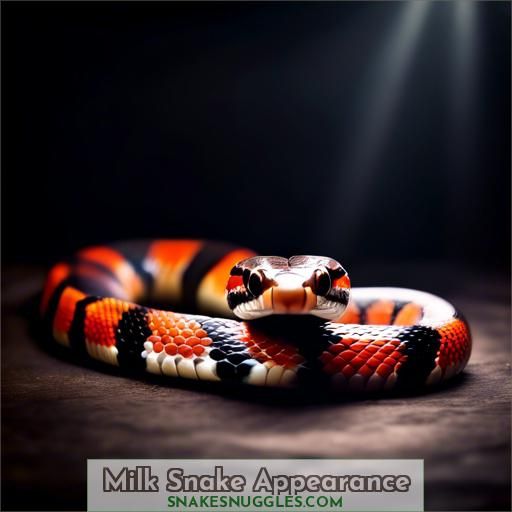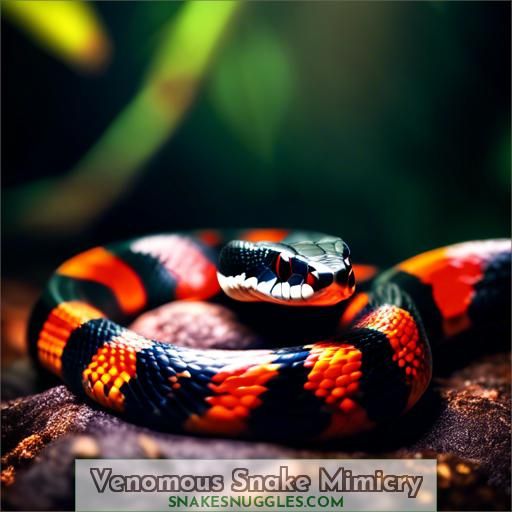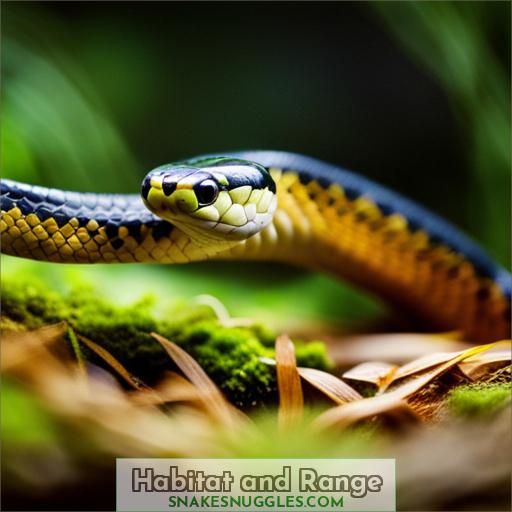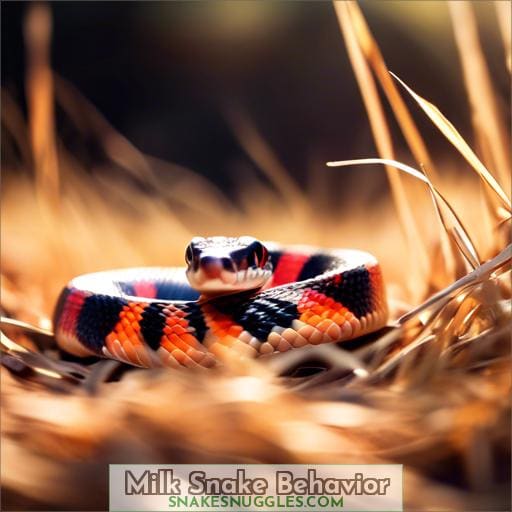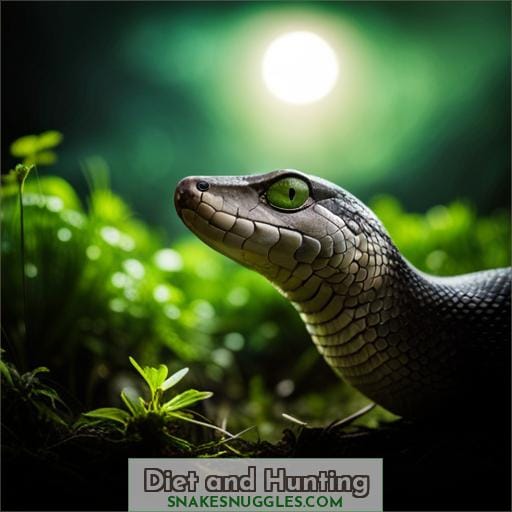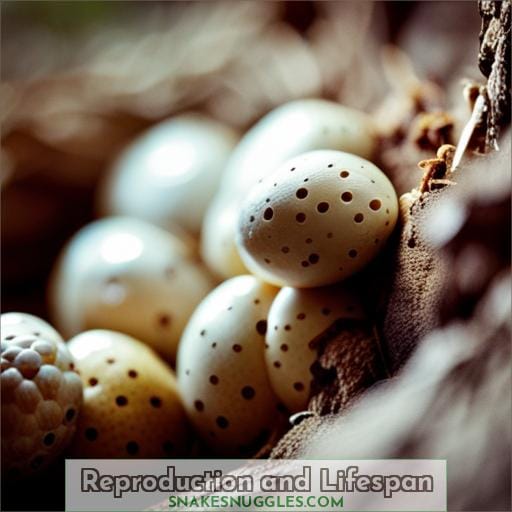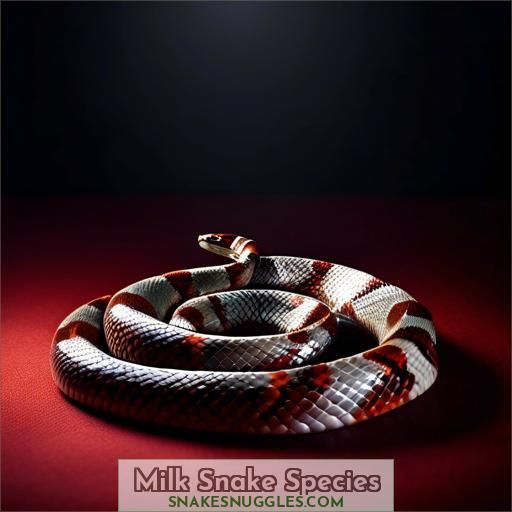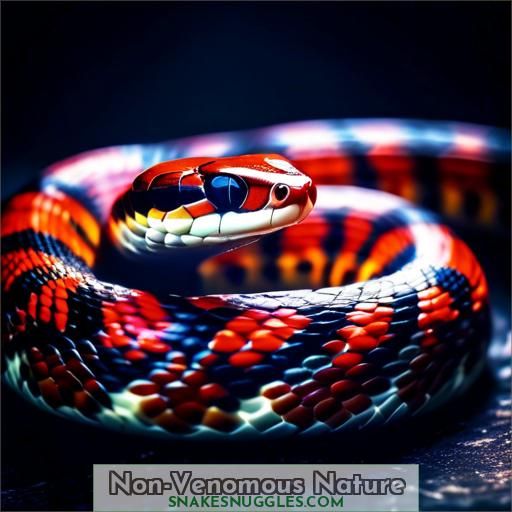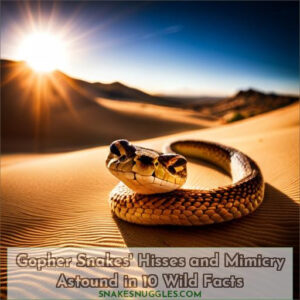This site is supported by our readers. We may earn a commission, at no cost to you, if you purchase through links.
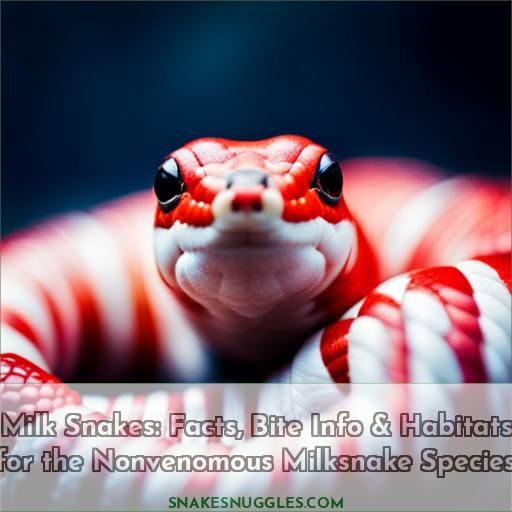 Milk snakes’ banded patterns and vibrant colors allow them to mimic venomous coral snakes as a defense strategy. Non-venomous themselves, these harmless mimics also shake their tails and adopt striking poses to ward off predators.
Milk snakes’ banded patterns and vibrant colors allow them to mimic venomous coral snakes as a defense strategy. Non-venomous themselves, these harmless mimics also shake their tails and adopt striking poses to ward off predators.
Inhabiting forests and fields, milk snakes are known for their solitary behavior and nocturnality. They lay clutches of eggs, and hatchlings emerge fully independent. Their lifespan can extend up to 22 years in captivity.
Table Of Contents
Key Takeaways
- Milk snakes are non-venomous and harmless to humans, despite mimicking the appearance of venomous coral snakes.
- They have a diverse diet, including mammals, birds, reptiles, and even venomous snakes.
- Milk snakes lay eggs, and hatchlings emerge fully independent.
- They have a wide geographic range, spanning North and South America.
Milk Snake Appearance
When it comes to the appearance of milk snakes, they’re known for their banded patterns and vibrant colors. These snakes can be found in various colors like white, red, black, yellow, and orange, with darker bands outlined in black. One of their most distinctive features is the light-colored Y or V shape on their neck.
Milk snakes are often confused with venomous snakes due to their mimicry as a defensive strategy. They’re sometimes mistaken for copperheads and coral snakes. Copperheads have an hourglass shape, while coral snakes have red and yellow bands next to each other. Milk snakes, on the other hand, have rounded, thick bands and may shake their tails to mimic rattlesnakes.
These new world snakes have a wide geographic range, inhabiting forests, fields, rocky outcroppings, agricultural areas, and barns. They prefer forested areas and spend much of their day under rocks or in dark places.
Despite their appearance, milk snakes are non-venomous. Their mimicry is their greatest defense mechanism. They come in 25 subspecies, each with slight color variations. For example, the Sinaloan milk snake has red bands separated by black and yellow bands, resembling the venomous coral snake.
Venomous Snake Mimicry
Milk snakes have evolved to mimic the appearance of venomous coral snakes as a defense mechanism against predators. This mimicry helps them avoid being eaten by animals that fear coral snakes’ deadly venom.
Coral Snake Lookalikes
You’ve likely seen milk snakes’ striking banded colors and wondered, Is that a coral snake? No surprise – these harmless serpents mimic deadly coral snakes to scare off predators.
- Shaking tails like rattlers
- Adopting striking poses
- Flashing their uncannily coral snake-like patterns
But remember: Red on yellow kills a fellow, red on black – venom lack. Milk snakes pose zero threat, unlike their venomous mimicry models across their shared ranges. Their convincing act simply helps these slithery impostors survive.
Defensive Behaviors
Milk snakes employ a variety of clever defense mechanisms to avoid becoming prey. One of their most distinctive behaviors is tail rattling, where they shake their tails to mimic the warning signal of venomous coral snakes. This bluff is a way for milk snakes to deter potential threats without the need for venom.
Milk snakes are also adept at using chemical cues to navigate their environment and avoid becoming someone else’s meal. This keen sense of smell and ability to detect chemical signals helps them stay one step ahead of predators.
Despite their intimidating appearance and behavior, milk snakes are actually harmless to humans. Their bites, while startling, lack any venom and pose no serious threat. This combination of bluff and bravery makes milk snakes fascinating subjects to observe in the wild, with each encounter offering a glimpse into the cunning adaptations of these remarkable reptiles.
Habitat and Range
Milk snakes are found across a broad geographic range spanning North and South America. These versatile reptiles can thrive in a variety of habitats, from lush forests to arid deserts. Their expansive territory stretches from southeastern Canada down through the eastern United States, across the Midwest, and into Mexico and Central America.
What makes milk snakes so adaptable? Consider these key factors:
- Diverse Habitat Preferences – Milk snakes feel at home in coniferous and deciduous forests, open woodlands, rocky hillsides, prairies, and even agricultural areas near human settlements.
- Wide-Ranging Distribution – Their range covers almost the entire eastern half of North America, as well as much of Mexico and parts of Central America.
- Tolerance for Varying Climates – Milk snakes can survive in environments ranging from cool, temperate forests to warm, tropical regions.
Milk Snake Behavior
Milk snakes are largely solitary and primarily nocturnal, spending their days under rocks or in dark places to escape the heat.
Nocturnal Activity
As the sun sets and darkness blankets the land, the milk snake emerges from its daytime hiding spot, ready to embark on its nocturnal adventure. With its exceptional night vision, it can easily navigate the moonlit landscapes, its keen eyesight allowing it to detect even the slightest movement. It’s an adept hunter under the cover of night, using its stealthy movements to approach unsuspecting prey.
Milk snakes aren’t venomous, but they’ve evolved to mimic the appearance of dangerous snakes as a defense mechanism. This clever strategy helps them to avoid predators and survive in their environment.
| Attribute | Description |
|---|---|
| Size | Ranges from 14 to 69 inches |
| Coloration | Banded with varying colors (white, red, black, yellow, orange) |
| Habitat | Forests, fields, rocky outcroppings, agricultural areas, barns |
Brumation (Winter Dormancy)
Milk snakes, like many reptiles, undergo a process called brumation during the winter months. This is a period of reduced activity and metabolism, similar to hibernation in mammals.
- Brumation Triggers: Milk snakes are triggered to brumate by cooler temperatures and shorter daylight hours.
- Hibernation Conditions: They seek out cool, dark places to rest, often in communal dens with other snakes.
- Temperature Preferences: Milk snakes prefer temperatures between 45-60°F (7-15°C) during brumation.
- Winter Activity: Unlike some venomous snakes, like copperheads and rattlesnakes, milk snakes don’t venture out during the winter.
Brumation is a crucial part of a milk snake’s life cycle. It helps them conserve energy and survive the harsh winter conditions. So, next time you see a milk snake, remember, it’s just taking a winter nap!
Diet and Hunting
Milk snakes are known for their diverse diet, which includes a variety of prey types. They primarily feed on mammals, birds, and reptiles, such as coral snakes. Milk snakes are also immune to the venom of the venomous snakes they consume, making them a formidable predator in their environment.
Milk snakes employ different hunting strategies depending on their prey. For example, they use constriction hunting to subdue their prey, which is a common method among many snake species. Additionally, milk snakes may also prey on reptile eggs and consume eggs from other reptiles.
To understand the dietary habits of milk snakes, consider the following table:
| Prey Type | Dietary Importance |
|---|---|
| Mammals | Primary source of protein |
| Birds | Secondary source of protein |
| Reptiles | Source of essential nutrients |
| Coral Snakes | Source of venom immunity |
| Eggs | Source of essential nutrients |
In the wild, milk snakes are known to be opportunistic eaters, taking advantage of available food sources. This dietary diversity ensures that milk snakes can thrive in various habitats and adapt to changing prey availability.
In captivity, milk snakes are often fed a diet of rodents, which can be purchased from pet stores or bred specifically for snake food. This ensures that captive milk snakes receive a balanced diet and maintain their health.
Reproduction and Lifespan
Milk snakes are egg-laying reptiles, with females laying clutches of 2-17 eggs in warm, humid places. Once hatched, the young snakes are typically 6-7 inches long and reach full maturity between 3-4 years of age.
Egg Laying
As a milk snake, you’re oviparous, meaning you lay eggs to reproduce. Your egg-laying habits are fascinating! You typically mate in the spring, and females lay their eggs in warm, humid places like compost piles or rotting logs. Clutch size varies depending on the species, but you can lay anywhere from 2 to 17 eggs.
After laying your eggs, you don’t provide any postpartum care. The eggs incubate for several weeks, and the hatchlings emerge fully independent. They’re born with a full set of teeth and can hunt for food right away. It’s a remarkable process that ensures the survival of your species.
Hatchling Size
As a hatchling, a milk snake is typically around 6-7 inches in length. Their diet consists of small rodents, such as pinky mice, which should be offered weekly.
As they grow, the food size should be increased until they’re taking large mice or even jumbos.
Adult milk snakes can be fed once every two weeks, but they may become overweight if fed weekly.
Milk Snake Species
The milk snake family boasts an impressive diversity, with 24 distinct species slithering across the globe. These snakes showcase a kaleidoscope of colors and patterns, each subspecies adorned with unique markings. Despite their captivating appearance, milk snakes share a common bond: their non-venomous nature.
Their geographic distribution spans the Americas, from the bustling cities of the United States to the lush rainforests of South America. Each species has meticulously adapted to its surroundings, thriving in a wide range of habitats, from arid deserts to verdant forests.
Indigenous communities have a deep reverence for milk snakes, recognizing their cultural significance and ecological role. Their presence in folklore and traditional medicine reflects the intricate relationship between humans and these fascinating creatures.
While milk snakes may not possess venom, they employ a clever defense mechanism: mimicry. Their banded patterns and vibrant colors resemble those of venomous coral snakes, deterring potential predators. This strategy highlights the power of deception in the animal kingdom.
Despite their non-toxic nature, milk snakes face challenges in the modern world. Habitat loss, fragmentation, and human persecution threaten their survival. Conservation efforts are crucial to ensure the continued presence of these captivating snakes in our ecosystems.
Size and Physical Traits
Milk snakes are a diverse group of snakes known for their striking appearance and unique color patterns. These snakes are found throughout North and South America and can be distinguished by their banded coloration, which varies from white, red, black, yellow, and orange. The bands are often outlined in black, and a light-colored Y or V shape can be found on the neck of many milk snakes.
One of the most interesting aspects of milk snakes is their ability to mimic the appearance of venomous snakes, such as copperheads and coral snakes. This mimicry is a defensive strategy used to deter predators. Milk snakes with red and black bands next to each other, unlike coral snakes, and their rounded, thick bands differentiate them from copperheads’ hourglass shape. Some milk snakes may even shake their tails to mimic the rattle of a rattlesnake.
Milk snakes inhabit a wide range of habitats, from forests and fields to rocky outcroppings and agricultural areas. They’re often found in barns and other areas where rodents are abundant. Milk snakes are primarily nocturnal and spend much of their day under rocks or in dark places. They’re solitary and prefer forested areas, but they can also be found in urban environments.
Milk snakes are oviparous, meaning they lay eggs. Females typically mate from March to May and lay 2-17 eggs in warm, humid places. Hatchlings range from 6-7 inches and reach full maturity between 3-4 years. Milk snakes can live up to 22 years in captivity, although their lifespan in the wild is unknown.
There are 25 different subspecies of milk snakes, each with slight color variations. For example, the Sinaloan milk snake has red bands separated by smaller black and yellow bands, which resemble the venomous coral snake found in the same area. The size of milk snakes varies, with some species reaching lengths of up to 69 inches. They’ve 19-23 rows of scales and a single anal plate.
Milk snakes are opportunistic eaters and consume a variety of prey, including mammals, birds, and reptiles. They use constriction to subdue their prey and are immune to the venom of venomous snakes they consume. Milk snakes aren’t venomous and don’t suck milk from cows, as is often believed.
Milk Snake Pictures
Let’s venture into the captivating realm of milk snake photography, where vibrant scales shimmer and patterns dance. The Sinaloan milk snake, a denizen of Mexico’s arid lands, boasts a striking appearance with its broad red bands separated by black and yellow. Its resemblance to the venomous coral snake is uncanny, a clever camouflage that wards off predators.
Witness the milk snake’s opportunistic feeding habits as it slithers through its rocky habitat. From reptile eggs to small mammals, these snakes are versatile predators, even immune to the venom of their venomous prey. Their ability to subdue prey by constriction is a testament to their strength and cunning.
Milk snakes aren’t your average snakes. Their resilience and adaptability make them fascinating subjects for photography. Capture their nocturnal prowls, their sun-basking moments, and their communal dens during winter. Let your lens unravel the secrets of these nonvenomous charmers, revealing their beauty and ecological significance.
Non-Venomous Nature
Unlike their venomous counterparts, milk snakes are completely harmless to humans. They lack venom glands and fangs, rendering them incapable of delivering a venomous bite. Rest assured, you can observe these fascinating creatures without any fear.
Milk snakes possess an intriguing adaptation that allows them to consume venomous snakes, such as coral snakes, without suffering any ill effects. Their bodies have evolved an immunity to the venom of these snakes, enabling them to enjoy a unique and daring delicacy.
Pueblan milk snakes, a subspecies found in Mexico, exhibit a remarkable reproductive strategy. They’ve the ability to store sperm from multiple matings, allowing them to fertilize eggs even after the male has departed. This reproductive prowess ensures the continuation of their lineage.
The distinction between milk snakes and venomous snakes, such as coral snakes and copperheads, is crucial for their survival. Milk snakes mimic the vibrant colors and patterns of these venomous species as a defense mechanism, deterring predators from attacking. Understanding these differences empowers you to appreciate the fascinating world of snakes and their remarkable adaptations.
Frequently Asked Questions (FAQs)
What is the scientific name for milk snakes?
Their scientific name is Lampropeltis. As non-venomous snakes, they’re often mistaken for the venomous coral snake.
Where are Sinaloan milk snakes primarily found?
Sinaloan milk snakes are primarily found in Mexico, specifically in the states of Sonora, Sinaloa, and Chihuahua.
What is the average lifespan of a milk snake in captivity?
In captivity, milk snakes can live an astonishingly long life, up to a fantastic 22 years! That’s six times longer than their wild counterparts.
What type of eggs do milk snakes lay?
Milk snakes lay oblong, parchment-like eggs. These eggs are typically white or cream in color and range in size from 2 to 3 centimeters in length.
How do milk snakes subdue their prey?
Milk snakes conquer their prey using a deadly dance of constriction. They wrap their powerful coils around their victim, squeezing until life fades away.
Conclusion
Have you ever encountered a snake that resembles a venomous coral snake but is harmless? Meet the milk snake, a fascinating reptile that showcases the art of mimicry. These snakes remind us that nature’s deceptions can be both captivating and educational, highlighting the importance of careful observation and understanding in the realm of wildlife.
As you delve into the world of milk snakes, you’ll discover their unique appearance, defensive behaviors, and non-venomous nature. Milk snakes are known for their striking resemblance to coral snakes, which are highly venomous. This similarity is an example of Batesian mimicry, where a harmless species evolves to mimic the appearance of a dangerous one, deterring potential predators.
Despite their coral snake-like appearance, milk snakes are completely harmless to humans. They are non-venomous and pose no threat, though they may still display defensive behaviors like flattening their heads or vibrating their tails when threatened.
This behavior is likely an attempt to mimic the warning signs of their venomous counterparts.
The milk snake’s fascinating adaptations serve as a reminder of the complexity and diversity of the natural world. By understanding the nuances of these reptiles, we can appreciate the intricate relationships and evolutionary strategies that shape the ecosystems around us.

